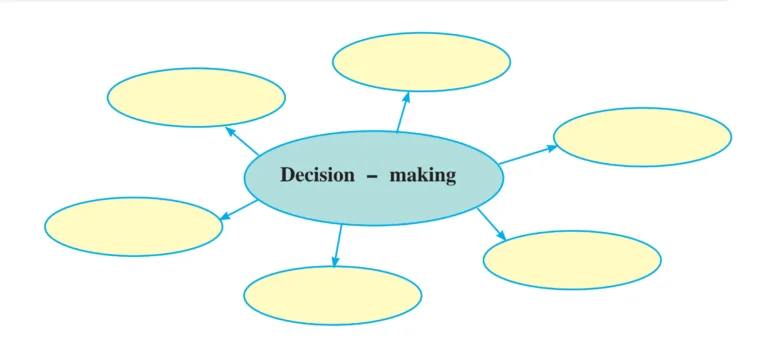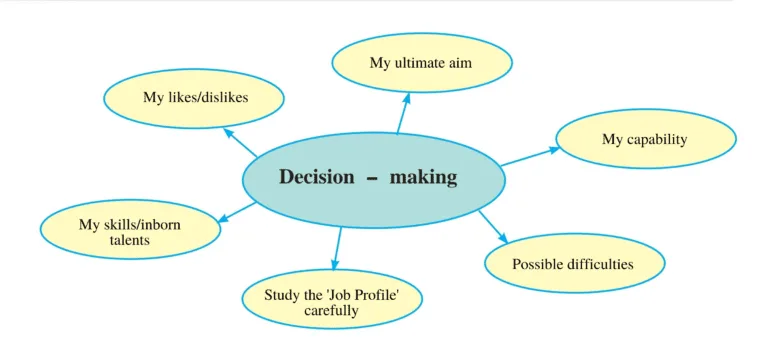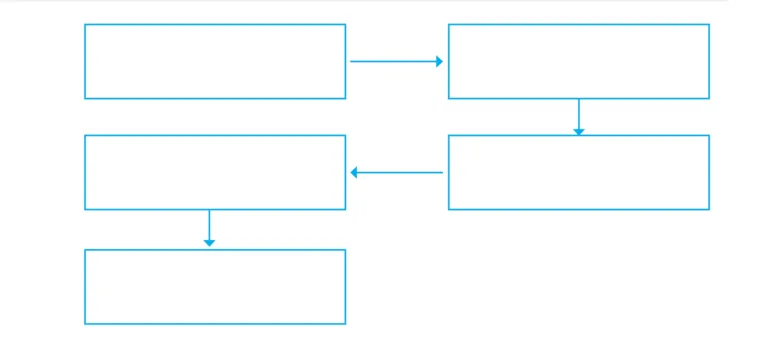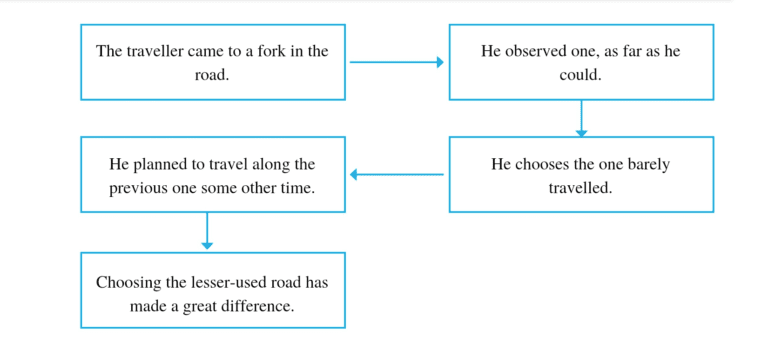Chapter 3.3 - The Road Not Taken
The poet is standing at a fork in a road in a forest where the trees have yellow leaves. There are two roads going in separate directions. He is sorry that he cannot travel on both roads. He stands there for a long time and peers down one road until the place where it bends and is covered with bushes.
Then he takes the other road, which was just as good. He felt more attracted to it because it was grassy and did not seem much used, though at the fork both roads seemed equally well-used.
That morning, they appeared to be equally covered in leaves that had not been blackened by human footstep. He chose one road and kept the first one for another day. However, he knew how one decision led to another, and he doubted if he would ever come back.
He says that he will be telling this with a sigh somewhere many, many years later: that when two roads went in different directions in a wood, he took the one that was less travelled by. and that has made all the difference in his life.
Title: The Road not Taken
Author: Robert Frost
Rhyme Scheme:
abaab, cdccd, efeef, ghggh.
Theme/Central idea:
It is about the poet’s journey through life and what he decides when he reaches a fork in the road. He tells us about a time that he came across two roads that diverged in a wood. He knew that he could not travel both ways, so he took the road that was less travelled. It made a difference in his life.
Favourite lines:
I took the one less travelled by,
And that has made all the difference.
Figure of Speech:
Alliteration. Though as for that the passing there.’ Repetition of the sound of the letter ‘t’.
Special Feature/Implied meaning, etc.:
The symbolism used brings out the message beautifully. The poem is an extended metaphor. The two roads that diverge stand for the choices we have in our lives. It makes us think about how we make our choices and the difference our decisions can make.
Why I like/don’t like the poem:
I like the poem because it makes me think about my actions when I am faced with choices.
Warming up!
1. After your SSC Exams/Result you may have to take a decision regarding the choice of a career. What factors will you consider ?
Choose from the block below and complete the web-diagram.
(1) Is the option easy/difficult ?
(2) Your capability
(3) Your likes/dislikes
(4) Friends’ decision
(5) Parents’ profession
(6) Your skills/inborn talents
(7) Study the ‘Job Profile’ carefully
(8) Easy money
(9) Possible difficulties
(10) Your ultimate aim

Ans:

2. Form pairs or groups of four. Think of the situations when you have to choose between two things. Make a list of those situations. Some of them may be minor or trivial things – for example, what to wear when going out. Some choices may be related to important things, for example, having to decide between games and studies, whether to confront a close friend about something that he/she did, owning up to your mistakes, etc.
(a) Discuss how to decide what to choose.
Ans: This decision should be taken on the basis of our likes, dislikes, capabilities, skills, inborn talents, possible difficulties, etc.
(b) Write what you feel when your decision proves right.
Ans: I feel happy, empowered and more confident when my decision proves right.
(c) Write what you feel when you regret the decision.
Ans: I feel bad and unmotivated but it gives me a new desire to stand up and start something new.
In Between the Poetry!
Q1. Why does the poet feel sorry?
Ans: The poet feels sorry that he cannot travel along both the roads at the same time.
Q2. Did the poet choose the road quickly?
Ans: No, the poet did not choose the road quickly. He stood for a long time at the fork before took a decision.
Q3. Was one of the roads better than the other?
Ans: No. Both were good.
Q4. Does the poet tell us what difference it made?
Ans: No, he doesn’t.
ENGLISH WORKSHOP
1. Read the poem again. Does it have a uniform rhyme scheme throughout? Write down the rhyme scheme of every stanza separately.
Ans: Yes, it has a uniform rhyme scheme throughout.
Rhyme scheme of each stanzas are:
1st stanza – abaab
2nd stanza – cdccd
3rd stanza – efeff
4th stanza – ghghh
2. Write the symbols that are used in the poem to represent the following ideas.
(a) Choice of two options
Ans: two roads diverged.
(b) I made a rare choice
Ans: I took the one less travelled by.
(c) Equally good options
Ans: Just as fair.
(d) It was tempting and needed to be tried
Ans: It was grassy and unwanted wear.
(e) Some other time
Ans: Another day.
3. Rearrange the following facts in the proper order and fill in the flow chart.
(a) He chooses the one barely travelled.
(b) Choosing the lesser-used road has made a great difference.
(c) He observed one, as far as he could.
(d) The traveller came to a fork in the road.
(e) He planned to travel along the previous one some other time.

Ans:

4. Think and write in your own words.
(a) In which season does a greenwood turn to a yellow wood? Which stage in our life can be compared to that season?
Ans: A greenwood turns to a yellow wood in autumn. The stage in our lives that can be compared to that season is middle age.
(b) Why did the traveller choose the road less travelled? What attribute of the traveller does it bring out ?
Ans: The traveller chooses the road less travelled because it seemed just as good as the other one and he felt it needed to be used. The traveller seems to be adventurous. He has his own mind and does not want to follow what others have done.
(c) Why does the traveller doubt that he shall ever come back?
Ans: The traveller feels that he will be so busy in his life, with one thing leading to another, that he may not be able to come back.
(d) If you were in the traveller’s place, which road would you choose ? Justify your choice.
Ans: If I were in the traveller’s place I would choose the road that was more travelled. I would not want to go on a strange road that many have not travelled. I am not adventurous. I feel that there is safety in doing what others are doing or have done.
5. From any collection of classic poetry or the internet, find another famous poem by Robert Frost titled ‘Stopping by the woods on a Snowy Evening’. Try to understand the symbolism used in that poem in 8-10 lines.
Ans:
Stopping by Woods on a Snowy Evening
– Robert Frost
Whose woods these are I think I know.
His house is in the village though;
He will not see me stopping here
To watch his woods fill up with snow.
My little horse must think it queer
To stop without a farmhouse near
Between the woods and frozen lake
The darkest evening of the year.
He gives his harness bells a shake
To ask if there is some mistake.
The only other sound’s the sweep
Of easy wind and downy flake.
The woods are lovely, dark and deep,
But I have promises to keep,
And miles to go before I sleep,
And miles to go before I sleep.
Robert Frost’s poem “Stopping by the Woods on a Snowy Evening” symbolises the journey of life and a movement towards death. In that sense, almost every single element in the poem is symbolic of something. The undefined traveller on horseback reminds us of the knights of the Middle Ages in the course of a heroic adventure. The cold and the dead of night and the frozen lake in the woods—the “darkest evening of the year”—all these elements build an ambience where the immanence of death is at odds with the indomitable spirit of love, as exemplified by the traveller.
The owner of the woods is referred to, but his name has not been mentioned. This can be a reference to the mystic and almost unnameable presence of God. The oath of the traveller is to go on, come what may, keeping his promises before he has to submit to the final call of death, an eternal sleep of sorts. The end of the poem is thus replete with philosophical symbolism.
6. Write a letter to your friend or cousin telling him/ her about a difficult choice you have recently made, for example, pursuing one sport or hobby rather than the other or choosing between your studies and hobbies.
Tell your friend/ cousin how his/ her example helped you to take a decision.
Ans:
Dear Amaan,
It’s been a while since I’ve heard from you. Where have you been? I hope this letter finds you in the best of health.
Last month, I had to make a difficult choice. I had to choose between dancing and my studies. I had no idea what to do, as I am very passionate about both of them. Finally, I have decided to give up dancing for the next two years. It’s been a very difficult decision to make, but then I remembered what you had done. Your story was similar to mine. You focused on studies, and now you have both. This is what has inspired me to make my decision. Thanks a lot for this.
Let’s meet soon, and I’ll give you more details then.
Your Best Friend,
Kushal.
7. Collect quotations on the topic ‘choice’.
Example : ‘Decisions are the hardest thing to make, especially when it is a choice between where you should be and where you want to be.’
Present the quotations in a beautiful hand on card paper.
Ans:
“Life presents many choices, the choices we make determine our future.”
– Catherine Pulsifer
“May your choices reflect your hopes not your fears.”
– Nelson Mandela
“I discovered I always have choices and sometimes it’s only a choice of attitude.”
– Judith M. Knowlton
“Life is a matter of choices, and every choice you make makes you.”
– John C. Maxwell
“Life is a choice – as is how you handle the pitfalls along its bumpy road.”
– Julie Donner Andersen
“You always have two choices: your commitment versus your fear.”
– Sammy Davis Jr.
“Every choice you make has an end result.”
– Zig Ziglar
“Every day brings new choices.”
– Martha Beck
“In every single thing you do, you are choosing a direction. Your life is a product of choices.”
– Dr. Kathleen Hall
“We make our choices, then our choices make us.”
– Anonymous
